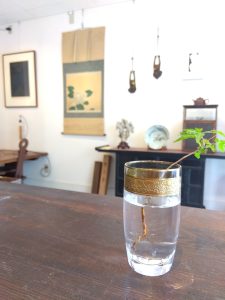骨董珊瑚の見分け方とお手入れ方法(愛知県名古屋市千種区姫池通 骨董買取 古美術風光舎)
2024.06.21
皆さまこんにちは、スタッフTでございます。
前回の珊瑚の種類に続き、本日はお持ちの珊瑚の見分け方とお手入れ方法のポイントについていくつか挙げていきたいと思います。

みなさま、珊瑚を持っていると気になるのが天然か偽物かということではないでしょうか?
珊瑚は昔から非常に希少価値の高い宝石だとして重宝されていることから、その分偽物も多く出回っています。また、天然であったとしても、希少価値の低い珊瑚を使って加工していたりする場合もあります。
珊瑚は不透明であることから素人目には価値を判断しにくい宝石だとも言われています。珊瑚の価値を知るには、最終的には鑑定士のところに持って行くのが一番ですが、ある程度はご自身で判定することも可能ですので、そのポイントをいくつか挙げていきます。
珊瑚を見分けるポイントは前回のブログでもご紹介した通り、ずばり「色」です。
珊瑚の種類は「赤」「白」「桃」「黒」と色で分けられているように、単純に色味によって珊瑚の種類は見分けることができます。白珊瑚や黒珊瑚は簡単に見分けることができますし、桃珊瑚も色味で見分けることができます。しかし、「血赤珊瑚」と「赤珊瑚」となると見分ける為にはもう少し詳しく知る必要があります。
赤珊瑚と血赤珊瑚の見分け方のポイントは「カラーグレードによって見分ける」ということです。
赤珊瑚のカラーグレードは「色味・色ムラ・ヒ・フ・白濁・キズ」などの点を、5段階で評価します。Sを最上級とし、S>A>B>C>Dの順にランク分けされます。一般的に「血赤珊瑚」は5~4までのカラーのことを指します。
そんな珊瑚は、きちんとお手入れすることも大切です。特に買取の際には、天然か偽物かであることだけでなく、日頃のお手入れの有無、コンディションも査定価格に影響してきます。天然珊瑚は一度変色してしまうと元に戻すことはできません。いくら希少価値の高い珊瑚であっても、人工的な傷や汚れは、その価値を一気に下げてしまいますので、ご注意ください。
お風呂や温泉、プール、調理時は、珊瑚ジュエリーを必ず外しましょう。珊瑚の主成分は「炭酸カルシウム」という成分で、硬度にすれば3.5程度、人間の歯の硬さと同じくらいです。簡単に傷がつきますので、扱うときには落としたり、ぶつけたり、こすったりしないように注意が必要です。お手入れの時もきれいな布や柔らかい素材のもので、表面のほこりや脂を拭う程度にするのが良いでしょう。
また、水や脂、熱の変化にも注意が必要です。
もともと海の生き物であった珊瑚ですから、水は平気とお考えの方もいるかもしれませんが、あまりおすすめできません。
珊瑚には小さな穴が無数に空いています。大きいものは「むし孔」と呼ばれ、見方によれば本物の珊瑚の証明でもありますが、この隙間に水分や脂が染み込んだままになりますと、変色や変質の原因となります。
水や手の脂など余計なものがついた時は、乾いた柔らかい布で優しく拭き取るのが良いでしょう。
また、過度な熱や急な温度の変化もよくありません。保管する際は日が当たる場所を避け、温度変化が少ない安定したところが適しています。
水そのものに触れるのはおすすめできませんが、保管のときに乾燥しすぎると劣化やヒビの原因になるので注意が必要です。
もし珊瑚だと思われる古いお品がありましたら、専門の鑑定士がいる骨董品店や買取店で査定してもらうことをおススメします。
もしかしたら、びっくりするほどのお宝かもしれませんよ。
ではでは、また。
Hello everyone, this is Staff T.
Following the previous article on coral types, today we would like to discuss how to identify and care for your coral.
If you have coral, you may be wondering whether it is natural or fake.
Coral has long been valued as an extremely rare and valuable gemstone, which is why there are so many fakes on the market. Even if the coral is natural, it may have been processed using less rare coral.
Coral is also said to be an opaque gemstone, making it difficult for the untrained eye to determine its value. The best way to know the value of coral is to take it to an appraiser in the end, but to some extent you can also determine the value yourself.
As mentioned in the previous blog, the key to identifying coral is simply its color.
As corals are classified by color as “red,” “white,” “peach,” and “black,” it is possible to distinguish types of corals simply by their color. White and black corals can be easily distinguished, and peach corals can also be distinguished by color. However, to distinguish between blood red coral and red coral, you need to know a little more about them.
The key to distinguishing between red coral and blood red coral is to distinguish them by color grade.
The color grade of red coral is evaluated on a five-point scale, with S being the highest grade and S>A>B>C>D. In general, “blood-red coral” refers to colors from 5 to 4.
S】No scratches or uneven coloration, and no defects on the luster side can be seen with the naked eye.
A] Slightly scratched, unevenly colored, or otherwise flawed, but not easily visible to the naked eye.
B] Defects such as scratches and color irregularities are visible to the naked eye.
C] Cracks are slightly noticeable. C] Cracks that are somewhat conspicuous, and flaws such as scratches and color irregularities that can be seen with the naked eye.
D] Cracks, uneven coloration, scratches and other defects are clearly visible.
Coral is considered to be more beautiful and valuable when it has a single color tone and is free from “flaws” and unevenness in color. Therefore, coral that is cloudy or has a marbled pattern tends to be difficult to obtain a high price.
By the way, what do the unfamiliar “fu” and “hi” mean?
The “hu” refers to the white spots and patterns found on Japanese red coral, and the “hu” corresponds to the bone part of the coral. The more even the color is, the more beautiful the coral is, so when the coral is round, a hole is made in the “rim” so that the “rim” is not visible on the surface when it is processed into jewelry. The “rim” is found only in Japanese red coral and not in Mediterranean red coral. This is why it is considered a sign of Japanese red coral and is used as a standard to distinguish it from Mediterranean red coral. Japanese blood red coral without “f” is considered to be of the highest quality.
A “fissure” is a crack. When corals are pulled up from the bottom of the deep sea, the difference in water pressure causes them to crack during collection.
Coral like this is also important to take good care of properly. Especially when purchasing coral, not only whether it is natural or fake, but also the daily care and condition of the coral will affect the appraisal price. Once natural coral is discolored, it cannot be restored. Please note that no matter how rare and valuable coral may be, artificial scratches or stains can quickly reduce its value.
Always remove your coral jewelry when bathing, bathing in hot springs, swimming pools, or cooking. The main ingredient of coral is calcium carbonate, which has a hardness of about 3.5, or about the same as the hardness of human teeth. It is easily scratched, so be careful not to drop, bump, or rub it when handling it. When caring for it, it is best to use a clean cloth or soft material to wipe off dust and grease on the surface.
Care should also be taken to avoid changes in water, grease, and heat.
Some people may think that since corals were originally sea creatures, water is not a problem, but this is not recommended.
Corals have numerous small holes in them. If moisture or oil seeps into these holes, it can cause discoloration and tarnishing.
When excess water or hand grease gets on the coral, it is best to gently wipe it off with a soft, dry cloth.
Excessive heat or sudden changes in temperature are also not good. When storing, avoid places exposed to the sun, and a stable place with little temperature fluctuation is suitable.
Exposure to water itself is not recommended, but too much dryness during storage can cause deterioration and cracks.
If you have an old item that you think is coral, please have it appraised at an antique store or a store where there are professional appraisers.
You may be surprised at what a treasure it could be.
See you soon.
*******************
ご実家の整理やお片付けなどをされている方のご相談などが多くございます。
お片付けなどくれぐれもご無理のないようになさってくださいませ。
風光舎では古美術品や骨董品の他にも絵画や宝石、趣味のお品など様々なジャンルのものを買受しております。
お片付けをされていて、こういうものでもいいのかしらと迷われているものでも、どうぞお気軽にご相談下さいませ。
また風光舎は、出張買取も強化しております。ご近所はもちろん、愛知県内、岐阜県、三重県その他の県へも出張いたします。
まずは、お電話お待ちしております。
愛知県名古屋市千種区姫池通
骨董 買取【古美術 風光舎 名古屋店】
TEL052(734)8444
10:00-18:00 OPEN

